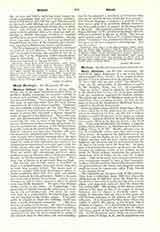

Mixteca Indians (also MISTECA, Latin, Mishteka), one of the most important civilized tribes of southern Mexico, occupying an extensive territory in western and northern Oaxaca and extending into Guerrero and Puebla. They number in all about 250,000 souls, or somewhat more than the whole Indian population of the United States together. Their eastern and southern neighbors are the rude Mixe and the cultured and powerful Zapotec, with the last named of whom they constitute a distinct linguistic stock, designated as the Zapotecan. The ancient culture and governmental forms of the Mixteca were practically the same as those of the Zapotec. They are now industrious farmers, weavers, and potters, the pottery manufacture, contrary to the Indian custom generally, being in the hands of the men. They stand high for industry and ingenuity, dignified and reliable disposition, hospitality and love of liberty. They were brought under Spanish dominion about the same time as the Zapotec and Mixe, in 1521-4, shortly after which the work of their conversion was begun by the Dominicans and prosecuted with such success that the whole nation may now be considered as Christian, notwithstanding some survivals from pagan times. They are active and enterprising, and have taken prominent part in Mexican politics, being particularly devoted to the Revolutionary cause in 1811. President Diaz of Mexico is of one-fourth Mixteca blood.
San Bartolo, one of their towns, is described by Starr as a delightful place, large and strung along two or three long straight streets. The houses were of poles set upright, with thick thatchings of palms, in yards completely filled with fruit trees, and garden beds of spinach, lettuce, and onions. Beehives in quantity were seen at nearly every house. Almost every woman was clad in native garments, many of which were beautifully decorated. The men wore brilliant sashes, woven in the town. At Teposcolula, “the great convent church historically interesting, is striking in size and architecture. The priest, an excellent man, is a pure-blooded Mixteca Indian, talking the language as his mother tongue. With great pride he showed us about the building, which was once a grand Dominican monastery…. The cura had ten churches in his charge. He seemed a devout man, and emphasized the importance of his preaching to his congregation in their native tongue and his. So convinced is he that the native idiom of the people is the shortest road to their heart and understanding, that he has prepared a catechism and Christian doctrine in the modern Mixtec, which has been printed.” The Mixteca language is spoken in a number of dialects and in spite of its peculiarly difficult character, has been much studied on account of the importance of the tribe. The standard authority is the “Arte en lengua Mixteca” of Fr. Antonio de los Reyes (Mexico, 1593, and reprinted at Mexico in 1750). The Indian priest author noted by Starr is Fr. Casiano Palacios, whose “Catecismo” was published in Oaxaca in 1896. Pimentel also devotes a chapter to the language. (See also Zapoteca Indians.)
JAMES MOONEY

